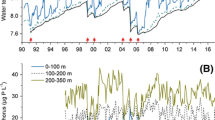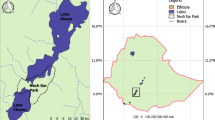Abstract:
This introductory article of the special GAP issue gives an overview on general limnological characteristics of the prealpine Lakes Zürich and Lucerne and the alpine Lake Cadagno and reports on the specific situation of primary production parameters during the international GAP Workshop in mid September 1999. Furthermore, it describes methods used for water analysis and fieldwork in these lakes.¶A comparison of data related to primary production in the three lakes in September 1999 during stratification shows that (i) phytoplankton community structure varied considerably between the lakes. The dominating algae were Planktothrix rubescens in Lake Zürich, various chrysophytes and diatoms in Lake Lucerne, and Echinocoleum elegans in Lake Cadagno, (ii) the euphotic zone in Lake Lucerne was considerably deeper (app. 15m) than in the other two lakes (app. 10 m), (iii) chlorophyll a standing crop was highest in mesotrophic Lake Zürich (August: 121 mg m-2), followed by oligotrophic Lake Lucerne (August: 75, September: 34 mg m-2) and mesotrophic Lake Cadagno (August: 33, September: 25 and 14 mg m-2), and (iv) areal primary production was highest in Lake Zürich (August: 105, September: 124 mg C m-2 h-1), followed by Lake Cadagno (August: 102, September: 52 mg C m-2 h-1) and Lake Lucerne (August: 90, September: 52 mg C m-2 h-1). Physiological parameters, determined in situ from P versus I relationships, showed a lower initial slope α in Lake Lucerne (August: 0.03, September: 0.02 mg C mg-1 chl a h-1μmol-1 m2 s) than in the other two lakes (Lake Zürich in August: 0.05, in September: 0.11; Lake Cadagno in August: 0.05, in September: 0.11 and 0.28 mg C mg-1 chl a h-1μmol-1 m2 s). Lake Zürich showed the lowest AN max (August: 2.6, September: 3.2 mg C mg-1 chl a h-1, as compared to 5.9 - 7.4 mg C mg-1 chl a h-1 in the Lakes Lucerne and Cadagno), while in Lake Cadagno the highest inhibitory effects of C-assimilation were found (highest slopes of inhibition β, 0.007-0.011, as compared to 0.0003-0.0026 in the other two lakes), due to a higher UV-exposure in this alpine lake.
Similar content being viewed by others
Author information
Authors and Affiliations
Additional information
Received 27 February 2001; revised manuscript accepted 22 June 2001.
Rights and permissions
About this article
Cite this article
Bossard, P., Gammeter, S., Lehmann, C. et al. Limnological description of the Lakes Zürich, Lucerne, and Cadagno. Aquat. sci. 63, 225–249 (2001). https://doi.org/10.1007/PL00001353
Issue Date:
DOI: https://doi.org/10.1007/PL00001353




